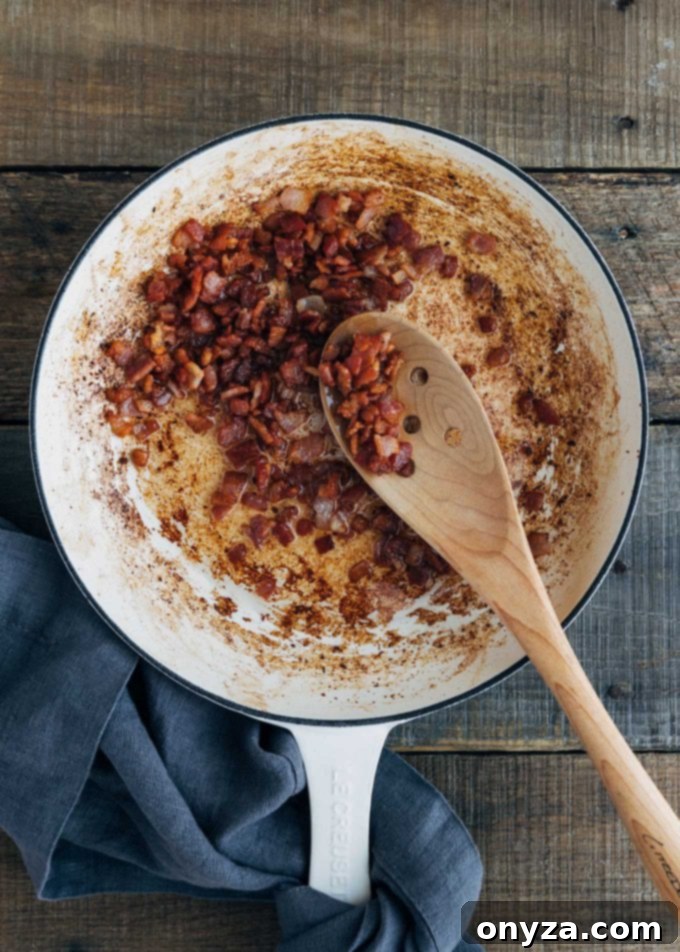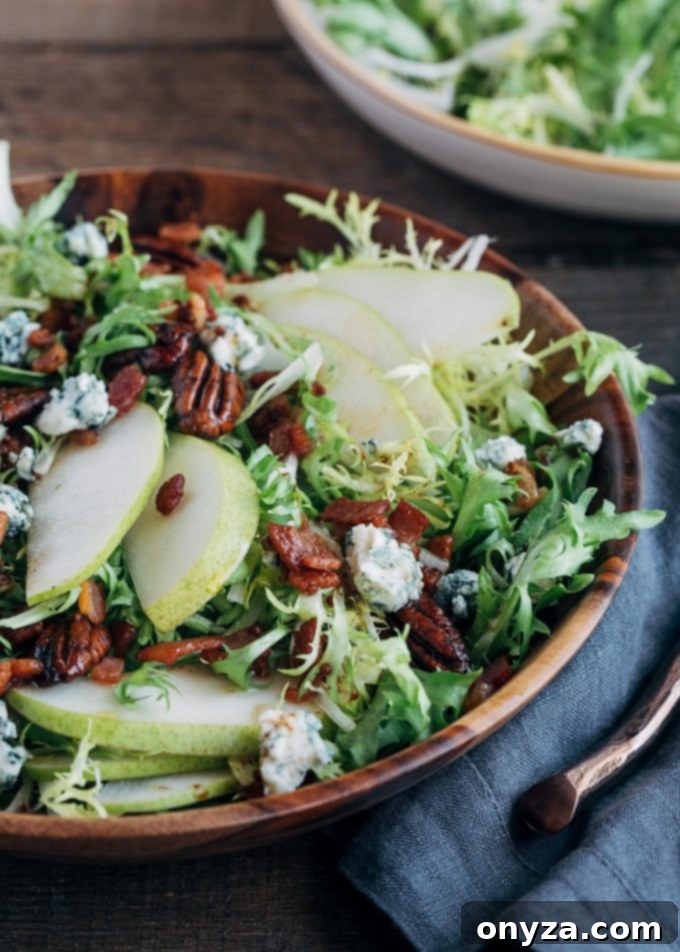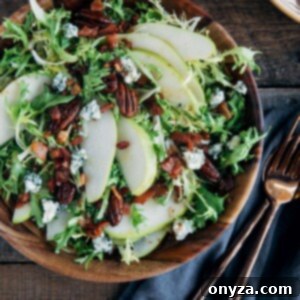Discover an exquisite blend of sweet and savory with this easy-to-prepare Pear Salad, perfectly complemented by a rich homemade maple-bacon vinaigrette. This beautiful dish is ideal for a light lunch or as an elegant first course throughout the cozy fall and winter seasons. Don’t miss the expert sommelier wine pairings, thoughtfully curated just for this recipe!
The cooler months of fall and winter are a fantastic time to indulge in a truly exceptional salad. This season naturally invites us to experiment with a harmonious balance of sweet and savory flavors, offering an abundance of fresh produce like succulent pears and bright citrus at the local market. Our Pear Salad recipe capitalizes on this seasonal bounty, transforming simple ingredients into a sophisticated culinary experience.
This delightful salad features tender frisée leaves tossed with a luscious, warm maple-bacon vinaigrette. It’s further elevated with crunchy pecans (whether you choose caramelized for extra sweetness or simply toasted for nutty depth), and savory crumbled blue cheese. Every forkful delivers a captivating symphony of tastes: sweet, salty, subtly peppery, and tangy, creating a truly delectable bite that will tantalize your palate.
Beyond its incredible flavor, this Pear Salad is a feast for the eyes, presenting a visually stunning arrangement on any plate. Whether you’re treating yourself to a luxurious lunch paired with a slice of artisan bread or serving it as an impressive starter for a festive holiday dinner, this Pear Salad is guaranteed to leave a lasting impression on your guests.

Selecting the Perfect Pears for Your Salad
Choosing the right pear variety is key to achieving the desired texture and sweetness in your salad. While almost any pear can be used, understanding their distinct characteristics will help you craft the perfect culinary masterpiece. Pears offer a wonderful contrast to bitter greens and rich dressings, making them an indispensable component of this recipe.
For the photographs featured in this post, I opted for firm yet ripe d’Anjou pears. Their availability and pristine appearance at the market on my shopping day made them an easy choice. Both the green and red varieties of d’Anjou pears are excellent for salads, known for their mild flavor profile with delicate notes of honey and a pleasantly crisp texture that holds up well when sliced.
Explore Other Pear Varieties at Your Market
Bartlett pears are perhaps the most iconic and widely available pear variety. Their classic “pear” flavor and juicy flesh make them a popular choice. For salads, I recommend using Bartletts when they’ve ripened to a yellow-green hue (Bartletts famously change color as they ripen). At this stage, they offer a delightful sweetness without being overly juicy, ensuring your salad isn’t watery.
If you prefer a distinctly crisp texture, Bosc pears or Asian pears are superb options. Bosc pears are identifiable by their russet-brown skin and elegant, elongated neck. When ripe, they develop a wonderfully sweet and slightly spicy flavor, along with a firm, almost crunchy flesh that adds fantastic bite to any salad.
Asian pears, often found with a protective netting sleeve, boast a texture remarkably similar to apples, offering a satisfying crunch. They possess a unique floral, mildly melon-like flavor, providing an intriguing twist to your pear salad.
For those who appreciate a sweeter, more succulent pear, the rounder and juicier Comice variety is an excellent, albeit delicate, choice (it’s one of my personal favorites!). Keep in mind that Comice pears are significantly sweeter than many other varieties, but their sweetness beautifully offsets the slightly bitter notes of frisée, creating a balanced flavor profile. Due to their delicate texture, Comice pears might break apart slightly during tossing. To mitigate this, toss your salad very gently, or for best results, arrange the pear slices artfully on top of the salad after the other ingredients have been mixed.
It’s worth noting that all pears will begin to oxidize and brown once their flesh is exposed to air. To preserve their pristine appearance between slicing and serving, simply dip the pear slices into a bowl containing a solution of half water and half lemon juice. This simple trick will keep them looking fresh and appetizing.

Understanding Frisée: The Signature Green for This Salad
Frisée, with its distinctive curly leaves and vibrant flavor, is a cornerstone of this salad. While often grouped with lettuces, it’s actually a proud member of the chicory family, alongside other robust greens like endive, radicchio, and escarole. You might recognize frisée from classic French bistro dishes, such as the renowned Salad Lyonnaise, where its character truly shines.
Frisée is cherished for its bitter, peppery flavor, which provides a delightful counterpoint to sweeter ingredients. Its delicate, curly texture adds incredible volume and visual interest to the salad, with leaves that gracefully transition from soft yellow hearts to darker green outer edges within a single head. When browsing your local market, you might also find it labeled as “curly endive,” a common alternative name.
The unique qualities of frisée are particularly delicious in this specific salad, forming a perfect partnership with the warm maple-bacon vinaigrette and the sweet pears. The balance of bitter, sweet, salty, and tangy flavors created by this combination is simply unparalleled and profoundly satisfying.
However, if bitter greens are not your preference, you can easily adapt this recipe. This salad would be equally exquisite made with tender baby spinach or your favorite spring mix. Both alternatives would harmonize beautifully with the other flavors in the pear salad, offering a milder green base without frisée’s more assertive bite, while still delivering a wonderful salad experience.

The Irresistible Warm Maple-Bacon Vinaigrette
If I had to declare a favorite type of salad dressing, anything generously drizzled with a warm bacon vinaigrette would undoubtedly take the top spot. Its smoky, tangy profile is incredibly addictive, and you truly don’t need a large amount to perfectly dress your greens and transform a simple salad into something extraordinary.
For this pear salad, I infused the dressing with a delightful hint of autumn by incorporating a touch of maple syrup. Maple and bacon represent a timeless culinary pairing, and their inherent sweetness and savoriness work exceptionally well with the tart apple cider vinegar and pungent Dijon mustard in this recipe, creating a truly balanced and complex flavor.
Preparing this Warm Bacon Vinaigrette is remarkably straightforward and quick to execute on the stovetop. The process begins by crisping the bacon to perfection. Once rendered, you’ll sauté finely chopped shallots in the flavorful bacon drippings, enhanced with a splash of olive oil. Next, whisk in your smooth Dijon mustard, apple cider vinegar, and the maple syrup, allowing the mixture to gently simmer for just a few minutes until it thickens slightly and coats the back of a spoon. The entire preparation, from start to finish, takes approximately 15 minutes total, making it a gourmet dressing that’s surprisingly easy to achieve.
While I generally adore grainy mustards, for this particular vinaigrette, I strongly recommend using a smooth Dijon mustard. The smooth texture of Dijon acts as a crucial emulsifier, helping to bind the dressing ingredients together and achieve that coveted luscious, creamy texture. I’ve experimented with grainy mustard for this recipe multiple times, and while still flavorful, it simply didn’t yield the silky, cohesive consistency that truly elevates this pear salad dressing to its full potential.
As the name suggests, Warm Bacon Vinaigrette should be served just as it sounds – warm, but not piping hot. After preparing it, allow the dressing to cool down slightly. The goal is for the vinaigrette to gently wilt the delicate greens, imparting a subtle tenderness without cooking them. This warm temperature ensures the flavors meld beautifully and the salad maintains its fresh appeal.

Sommelier Wine Pairings for Your Pear Salad
Elevate your Pear Salad experience by pairing it with a thoughtfully selected wine. Hugh Preece, a renowned Sommelier and Italian Wine Ambassador from Vinitaly Academy, has expertly suggested the following wines to complement the unique flavors of this dish:
Traditional Pairing:
CerettoLanghe D.O.C. Arneis ‘Blange’,Piedmont
This exquisite white wine from Piedmont offers a poised, fresh, and lively profile. It bursts with delightful floral and peach flavors, subtly underpinned by a hint of grapefruit and distinctive minerality, culminating in a delicate touch of almond on the finish. Its crispness and fruit notes will beautifully balance the richness of the bacon and the sweetness of the pears.
Daring Pairing:
MastroberardinoFalanghina del Sannio D.O.C, Campania
For a more adventurous pairing, this light-bodied and crisp white from Campania presents an intriguing profile. It showcases inviting aromas of ripe pineapples and various citrus fruits, complemented by fresh tarragon and bright Meyer lemon zest. Persistent notes of honeysuckle and toasted almond lead to a clean, chalk-tinged finish. Its vibrant acidity and complex fruit notes will cut through the richness of the dressing and highlight the salad’s fresh ingredients.

Pear Salad with Warm Bacon Vinaigrette
This beautiful fall and winter salad, featuring tender frisée, crisp pear slices, and a tangy maple-bacon vinaigrette, is wonderfully simple to prepare and a guaranteed showstopper when served.
Ingredients
- ¼ cup apple cider vinegar
- 1 teaspoon Dijon mustard
- 1-2 tablespoons maple syrup (adjust to your sweetness preference)
- 4 oz center-cut bacon (thick cut recommended), diced
- 1 tablespoon extra-virgin olive oil (plus additional, if needed)
- 2 tablespoons finely-chopped shallots
- 8 cups frisée lettuce, torn into bite-sized pieces
- 2 large pears, cored and sliced 1/8- to 1/4-inch thick
- ½ cup halved or caramelized pecans
- ⅓ cup crumbled blue cheese (Danish blue is a great choice)
- Kosher salt and freshly-ground black pepper, to taste
Instructions
- Whisk together the apple cider vinegar, Dijon mustard, and maple syrup in a small bowl. Set aside.
- Place diced bacon in a cold nonstick skillet. Cook over medium-high heat until the fat is rendered and the bacon is delightfully crispy. Remove the crispy bacon from the pan with a slotted spoon and set it aside, reserving the drippings.
- You should have approximately 3 tablespoons of bacon fat remaining in the pan. Add enough olive oil to the pan to reach a total of 4 tablespoons (1/4 cup) fat.
- Add the finely-chopped shallots to the pan and cook until softened and fragrant, about 3 minutes. Slowly and carefully pour in the reserved apple cider vinegar mixture, whisking continuously to combine thoroughly. Season with ¼ teaspoon of freshly-ground black pepper. Bring to a gentle simmer for about 2 minutes, just until the dressing slightly thickens and coats the back of a spoon.
- Stir about half of the cooked bacon bits back into the warm dressing, reserving the remaining crispy bacon to sprinkle over the finished salad. Allow the dressing to cool until it is just warm, then season to taste with additional salt and pepper as needed.
- In a large mixing bowl, gently toss together the frisée, sliced pears, approximately half of the prepared dressing, and the pecans. Season lightly with salt and pepper to taste.
- Serve the salad immediately, garnished with the crumbled blue cheese, an extra drizzle of the warm maple-bacon vinaigrette, and the remaining crispy bacon bits, if desired.
Notes
To prevent your beautiful sliced pears from browning due to oxidation, quickly dip them in a mixture of 50% water and 50% lemon juice immediately after slicing.
Nutrition Estimate
Calories: 361kcal | Carbohydrates: 30g | Protein: 8g | Fat: 23g | Saturated Fat: 6g | Cholesterol: 27mg | Sodium: 436mg | Potassium: 396mg | Fiber: 5g | Sugar: 20g | Vitamin A: 5445IU | Vitamin C: 12mg | Calcium: 111mg | Iron: 1.2mg
Nutrition information is automatically calculated and should be used only as an approximation.
Please note that our recipes have been developed using the US Customary measurement system and have not been tested for high altitude/elevation cooking and baking. Adjustments may be necessary based on your specific conditions.
Enjoyed this recipe? Please rate it and leave a comment below!
